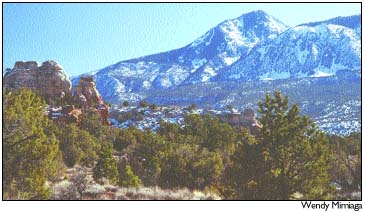|
April 3, 2001
By Jim Mimiaga WASHINGTON, D.C. — The Montezuma County commissioners arrived at the U.S. Capitol Monday on a fact-finding mission organized to test the increasingly choppy political waters swirling around the controversial Canyons of the Ancients National Monument. The commissioners are seeking face-to-face communications between them and lawmakers regarding the politically feasibility of modifying the monument so that local participation, concerns, and additional funding for protecting cultural resources are better assured. "We want to hear from the horse’s mouth about where we stand on this monument," said Commissioner Gene Story. "And if there is a chance to get on board with something that will make sure local interests are better represented, we might be willing to do that. "But at the same time we do not want to commit to anything that will take us down a road to nowhere." The lobbying move is due in part to recent pressure by a loud anti-monument movement within the county that is calling for action. Such sentiment is bolstered by recent Bush administration missives encouraging states with new monuments to come forward with any concerns. Bush’s new Interior secretary, Gale Norton, sent a letter March 28 to local governments in states that had monuments designated by Clinton in the last two years of his term. Norton has already said that overturning monuments is not a political reality given that it would require a two-thirds vote in a narrowly divided Congress. But her office has the power to influence the pending, and lengthy, management-planning process awaiting new monuments. "President Bush and I want to partner with local people at the beginning — not at the end of that process," Norton said. Mirroring local concerns that a new monument, with all its publicity, is a recipe for disaster without substantial extra funding to handle increased visitation, Norton remarked that "one of the most disturbing discoveries was that the previous administration took little trouble to assure that the monuments will be adequately maintained." Already, funding for Canyons of the Ancients is limited, with budgets for long-term planning still awaiting appropriations. Adequate funding is critical for preserving the 164,000-acre tract of desert canyonlands, considered to hold the largest collection of American Indian cultural ruins and sites in the nation. A local advisory board to help guide the management-planning process has yet to be formed by the Interior Department. "We really need to make sure that board has a cross-section of local representation — recreation, archaeology, ranching, oil and gas people, county government, the Ute (Mountain) tribe and so on," said commissioner Kelly Wilson. The Southwest Colorado Landowners Association, an agricultural-based, conservative action group centered in McElmo Canyon, has been seeking a resolution from the commission calling for monument annulment. Already nine resolutions from various boards and organizations — including the Ute Mountain tribe, Dolores Water Conservancy District, Southwest Cattlemen’s Association, the Navajo Nation’s Aneth Chapter, and Arizona, New Mexico and San Juan County, Utah, commissioners — have been drawn up expressing opposition to the monument. The landowners group asserts that the monument was created illegally, according to the 1976 Federal Land Management Policy Act, that it threatens traditional land uses, and that it was a top-down federal-government intrusion on local public lands. "Why are you letting the environmentalists influence you?" asked Chester Tozer, landowners president, at a recent commission meeting. "If you get on board, it will be much easier to get this overturned. "They always say ranching and oil and gas will stay in place, and that happens for a little while but then it is shut off." So far the commissioners have resisted drawing up such a resolution, and have been hesitant to take heed of a group they believe sabotaged the region’s best chance at becoming a National Conservation Area, a more grass-roots legislative designation with fewer land-use restrictions. That bill introduced by Sen. Ben Campbell, R-Colo. a year ago, but was it promptly dropped due to a lack of community consensus for it, which included the landowners group. Local monument supporters see the latest effort against Clinton’s land-preservation legacy as a moot point. "It does not make sense because this monument specifically preserves ranching, energy development, and multiple use," said Jeff Widen, a director of the Colorado Environmental Coalition. "Claims that these lands are being locked up isn’t true, especially if you look at how much federal land is out there that has virtually no restrictions for development." This week, the commissioners, along with federal-lands coordinator Mike Preston, will be meeting with congressional representatives, senators, Department of Interior officials and key public-lands committee heads in an attempt to flush out options that they will bring back to consider. "We’re not going with any set agenda," said Preston. "Rather, we are going to gather information and build connections that will be valuable during the planning process." |
||
|
Copyright © 2001 the Cortez Journal.
All rights reserved. |
